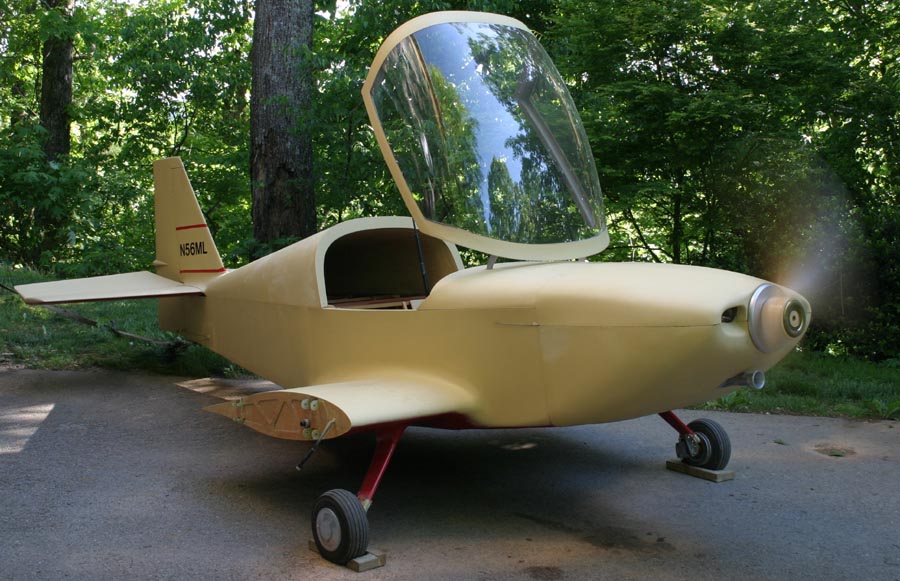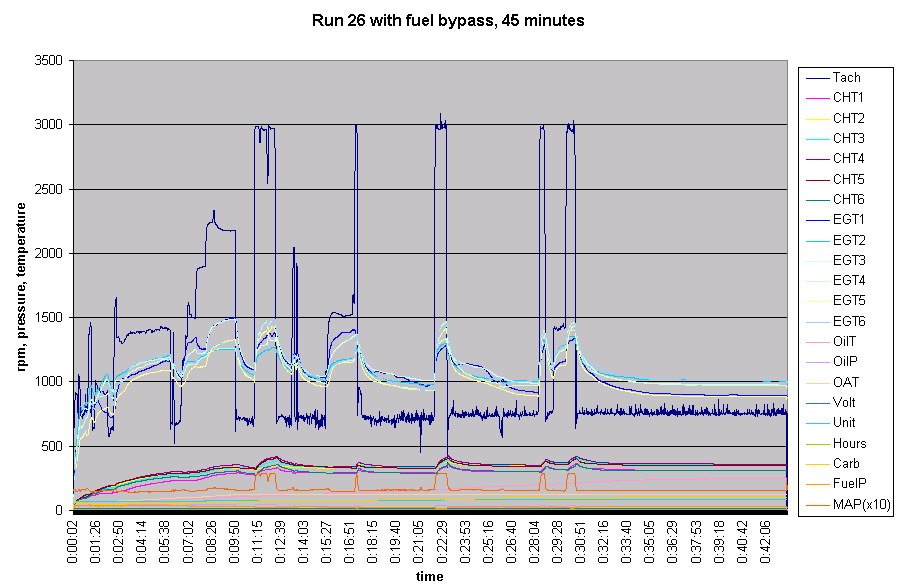Mark Langford's KP2S Project
Final Engine Testing
created May 5, 2005

I now have 10 hours on the engine, all on the ground, since the airplane hasn't flown yet. But I finally feel like this engine is ready to fly behind! The most recent hurdle was vapor lock if left to idle more than just a few minutes with warm ambient conditions. I'll be the first to admit that my engine compartment is a real hot box at idle, because it's very tightly cowled in an effort to reduce cooling drag at speed. It appears to be fine at wide open and mid ranges because enough air is circulating, and maybe because the NACA ducts that help suck that air out are working better. I'm pretty sure the engine compartment will be even cooler in flight. Right now the steady state under-cowling temperature is 160 degrees F, as measured by a Fluke digital thermometer. If I speed up the engine it cools off, so idle is worst case environment for the fuel system. 160F is well into the fuel vaporization range, so vapor lock isn't surprising.
Last week the engine would quit after only TEN minutes of idling. I was sucking air from inside the cowling because Ellison does not recommend ram air. But my carb air temp was pushing 120 degrees after 10 minutes of idling, and the engine would shutdown, showing a progressively leaning mixture, although fuel pressure was still fine. But Steve Makish has been using it for years on his Ellison carb, and I specifically designed my airbox to allow me to run ram air. So I carefully measured the cowling and cut a hole for a piece of 1.875" tubing, which slides neatly inside the ram inlet on my air box (by design). Then I topped it off with a Weber velocity stack. I'll fair this in before I fly it. Introducing an outside "ram" air source for the carb cooled the carb and its diaphragm considerably, by keeping inlet temps at ambient (about 75F right now), while cooling the diaphragm chamber by conduction through the aluminum carb body. I can still close off the ram air for first flights and sneak up on it at altitude, but I expect no problems running ram air at all. There is only one other port on the throttle body, and it's right in the inlet itself.
With my system, I normally had 6 psi of pressure at idle, but once the throttle was wide open and had a place to go, it dropped to about 2.6 psi. At idle, the fuel in the line was just barely moving and was absorbing heat from under the cowling, and eventually "boiling" to produce a vapor lock condition. Throttle body carbs like the Ellison are not very tolerant of fuel vapor in their diaphragm. Even with the outside air from the ram tube, after about 20 minutes of idling the engine was gradually get leaner and leaner until it just quit. My fuel pump is in the cockpit and below the wing tank level, so it is always primed. The fuel line that's under the cowling is only 18" long and thoroughly insulated by firesleeve, but it was still overheating after prolonged exposure to the high under-cowling temperatures.
I solved that one today, using a bypass pressure regulator to constantly circulate fuel. It's located just past the carb by means of a tee, and allows "excess" fuel to return to the wing tank, where it's cooled off due to airflow. I built in a fuel return when I designed my tank, thinking that someday I might want to run fuel injection. I'm glad I did! The regulator I used is the Barry Grant #171020 Diaphragm Bypass valve ($70). With AN fittings installed, it only weighs 8 ounces. This thing is made for alcohol burning dragsters, and is a bypass pressure regulator with a bleed orifice for idle. I don't think I'm even using the pressure regulating part of it, just the idle bleed orifice. It comes with a 175 jet in it, but it only gave me 1.9 psi of pressure at idle, so I put a 145 in it and now get 4 psi at idle, just about what I wanted. I was worried that my wide open throttle pressure would be too low with the bleed (Ellison says .5 psi minimum), but I now have about 2.1 psi at WOT, so that works great. I also think the bleed helps keep the mixture more constant throughout the range, as I don't need to adjust it all now from idle to wide open throttle!
The fuel pump is a lot happier these days too. It makes exactly the same sound all the time, and doesn't act like it's working very hard. I know it's cooler now.
I really think I can make the same thing out of two AN-6 male weldable ports welded back-to-back with an orifice sandwiched and screwed into the middle. I'll try that when I get a chance, and save 6 of those ounces. Somebody on ebay will get a deal on a brand new 171020. If done correctly, a calibrated bleed orifice would be even safer, because failure of the pressure regulator part could theoretically kill all pressure to your carb if it failed the wrong way. One other downside to the circulation is that a fuel totalizer won't work correctly, unless it's installed between the tee and the throttle body.
There was some discussion that perhaps the Ellison's diaphragm was overheating and causing the problem, but I had a thermocouple on it yesterday when it quit after 20 minutes due to overheating, and it read 160 degrees F. Today, after addition of the bypass, it still read 160 degrees, but ran for 45 minutes with no change in idle, so I got bored and switched it off. If I ever taxi anywhere that forces me to idle for 45 minutes, I'll be ready for the funny farm anyway. I'll keep an eye on the diaphragm chamber temps though, and if I need to, I already have the 1" SCAT tube on hand for a little blast tube. After switching the engine offthe under-cowling temps start to drop, so after fixing this idle problem, even hot starts will be assured.
 Here's an EIS plot of that engine run. There's nothing spectacular about it, other than the length of time for which it idled. I'd rev it up for a few seconds occasionally to make sure it would still run up, and to see what the temps did. The rpm drops are carb heat checks, and it works fine. EGTs are are a little wierd at idle, but I attribute that to fuel distribution being less than optimal in the idle mode.
Here's an EIS plot of that engine run. There's nothing spectacular about it, other than the length of time for which it idled. I'd rev it up for a few seconds occasionally to make sure it would still run up, and to see what the temps did. The rpm drops are carb heat checks, and it works fine. EGTs are are a little wierd at idle, but I attribute that to fuel distribution being less than optimal in the idle mode.
One more interesting thing I learned about my engine was that the number 5 terminal on the John Deere dynamo's regulator is exactly what I thought it was...power to "enable" the regulator and the idiot light. 601 builder Neil Hulin emailed me wondering if we could use that as a mechanism to kill the output of the dynamo if something went crazy. I pulled the wire off while the engine was running and the dynamo quit charging, and the idiot light didn't light because it no longer had juice to power the LED. I reconnected it and it started charging again. This is similar to how cars work (or at least worked at one time). It doesn't normally charge at idle, but charges at 12.8 volts above 1100 rpm, climbs to 14 volts at 1400 rpm, and then to 14.6 volts (the max for my system) at 1500 rpm. I'm sure current is a different matter, but I don't have a ammeter installed. Tests with loads applied will answer those questions later...
This engine is ready to go flying!
Return to Mark Langford's KR2S Corvair engine

 Here's an
Here's an